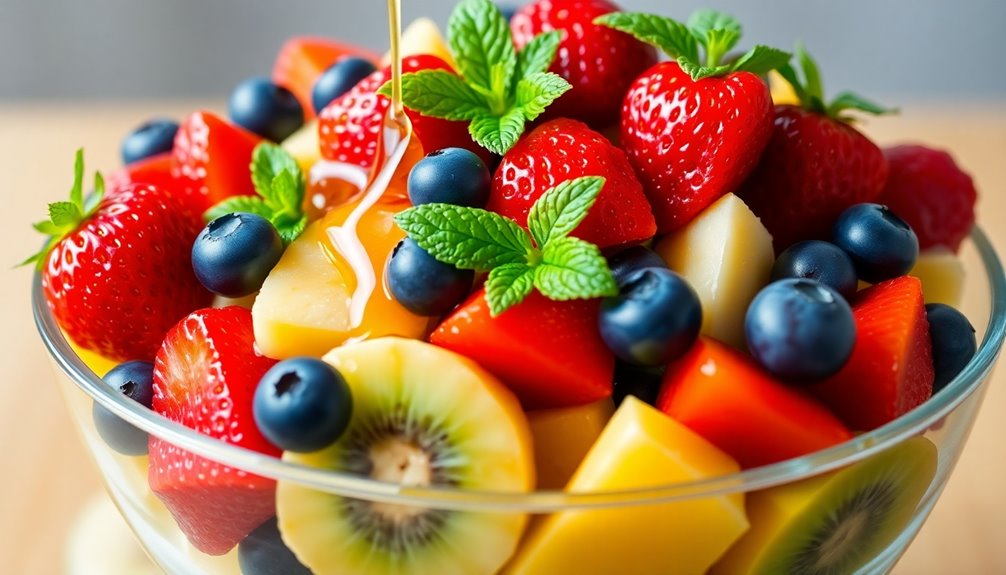To whip up a revitalizing fruit salad, start by selecting a colorful mix of seasonal fruits like strawberries, pineapple, and kiwi. Cut them into bite-sized pieces and drizzle with citrus juice for added zing. You can elevate the flavor by adding fresh mint and, if you like, a sprinkle of nuts or granola for crunch. Chill the salad for about 30 minutes to let those flavors meld together. It's perfect as a side dish or a healthy snack anytime. If you want to explore more ideas, stick around for tips and variations that can make your fruit salad even better!
Key Takeaways
- Choose a mix of fresh, seasonal fruits like strawberries, blueberries, pineapple, and kiwi for the best flavor and nutrition.
- Cut the fruits into bite-sized pieces and drizzle with citrus juice to enhance freshness and prevent browning.
- Optional: Add nuts, yogurt, or granola to increase texture and nutritional value in your fruit salad.
- Chill the salad for at least 30 minutes to allow flavors to meld together for a more enjoyable taste.
- Serve in decorative bowls and consider garnishing with mint leaves for an attractive presentation.
History

Fruit salad has a rich history that dates back centuries, with its origins rooted in ancient cultures. You'll find that the Greeks and Romans often mixed fruits with honey and spices, creating delightful combinations.
As trade routes expanded, exotic fruits made their way into various cuisines, each culture adding unique twists to fruit salads. In medieval Europe, fruits became symbols of wealth and were often served at banquets, showcasing their importance.
Over time, fruit salads evolved into popular dishes served in homes and at gatherings. Today, you can enjoy a myriad of styles, from simple mixes to elaborate presentations.
Embracing this history adds depth to every time you prepare or enjoy a fruit salad, connecting you to a long tradition of culinary creativity.
Recipe

Fruit salad is a revitalizing and vibrant dish that brings together a variety of flavors and textures, making it a perfect addition to any meal or a delightful snack on its own. This versatile dish can be customized according to seasonal fruits or personal preferences, allowing for endless combinations. Whether served at a summer barbecue, a festive gathering, or as a light breakfast, fruit salad is both nutritious and satisfying.
To make a fruit salad, you can choose a combination of fresh fruits that you enjoy, aiming for a mix of colors and sweetness levels. The key to a great fruit salad is using ripe, flavorful fruits as they'll elevate the entire dish. You can also add a simple dressing of honey and lime juice to enhance the natural sweetness of the fruits and add a zesty kick.
Ingredients:
- 1 cup strawberries, hulled and sliced
- 1 cup blueberries
- 1 cup pineapple, diced
- 1 cup kiwi, peeled and sliced
- 1 cup grapes, halved
- 1 banana, sliced
- 2 tablespoons honey
- 1 tablespoon lime juice
- Mint leaves for garnish (optional)
To prepare the fruit salad, begin by washing all the fruits thoroughly. In a large mixing bowl, combine the strawberries, blueberries, pineapple, kiwi, grapes, and banana. In a small bowl, whisk together the honey and lime juice until well blended. Drizzle the honey-lime mixture over the fruit and gently toss to combine, ensuring all the fruit is coated. Serve immediately or refrigerate for up to an hour before serving for a chilled treat.
When making fruit salad, consider using fruits that are in season for the best flavor and quality. You can also add other ingredients such as nuts, yogurt, or granola to enhance the texture and nutritional value. For added freshness, try incorporating herbs like basil or mint.
Keep in mind that some fruits, like bananas, may brown quickly, so it's best to add them just before serving if possible. Enjoy your delicious and colorful fruit salad!
Cooking Steps

To make a delicious fruit salad, you'll want to start by preparing a fresh selection of fruits.
Once you've got your fruits, cut them into bite-sized pieces and add a drizzle of citrus juice.
Mixing in fresh mint and chilling the salad before serving will elevate the flavors.
Step 1. Prepare Fresh Fruit Selection

A colorful array of fresh fruits can elevate any salad, making it not just delicious but visually appealing as well.
Start by selecting fruits that are in season for the best flavor and texture. Think about using a mix of sweet and tart options, like strawberries, blueberries, kiwi, and pineapple.
Consider adding citrus fruits for a revitalizing zing—oranges and grapefruits work beautifully. Make sure to choose ripe fruits, as they'll be juicier and more flavorful.
When you're at the market, check for firmness and vibrant colors. Don't forget to wash your fruits thoroughly to remove any pesticides or dirt.
With the right selection, you'll create a fruit salad that's not only healthy but a feast for the eyes!
Step 2. Cut Fruit Into Bite-Sized Pieces

Once you've gathered your fresh fruit selection, it's time to cut them into bite-sized pieces.
Start with the larger fruits like melons or pineapples. Use a sharp knife to slice them in half, then scoop out the flesh or cut it into cubes.
For berries, simply wash them and leave them whole, or slice them if you prefer smaller bites.
Next, tackle the softer fruits like peaches or kiwis; peel the skin and cut them into wedges or chunks. Aim for uniform sizes to guarantee even distribution in your salad.
Remember to remove any seeds or cores, which can be unpleasant to bite into. Your goal is to create a colorful mix that's easy to enjoy in every spoonful! Including a variety of fruits can enhance the overall flavor profile, similar to how a flavorful dumpling sauce complements an egg rollup.
Step 3. Add Citrus Juice Drizzle

As you prepare to enhance the flavor of your fruit salad, adding a citrus juice drizzle can elevate it to new heights.
Start by choosing your favorite citrus fruits—lemons, limes, or oranges work wonderfully. Squeeze the juice of one to two fruits into a small bowl, ensuring no seeds sneak in. If you want a touch of sweetness, consider mixing in a teaspoon of honey or agave syrup.
Whisk the citrus juice until well combined. Once your fruit salad is ready, drizzle the citrus blend evenly over the top. Use a spoon to gently toss the fruit, ensuring every piece gets a taste of that zesty goodness.
Let it sit for a few minutes to absorb the flavors before serving. Enjoy!
Step 4. Mix in Fresh Mint

Fresh mint can take your fruit salad to the next level with its vibrant flavor and aroma. To incorporate fresh mint, start by rinsing a handful of mint leaves under cold water to remove any dirt.
Pat them dry gently with a paper towel. Next, stack the leaves, roll them tightly, and slice them thinly to create mint chiffonade. This technique releases the essential oils, maximizing flavor.
Once your fruit salad is mixed together, sprinkle the freshly cut mint over the top. Use a spatula or spoon to gently fold the mint into the salad, ensuring it's evenly distributed.
This addition not only enhances the taste but also adds a pop of color, making your dish even more appealing. Enjoy!
Step 5. Chill Before Serving

To guarantee your fruit salad is invigoratingly cool and flavors meld beautifully, chilling it before serving is essential.
After you've mixed in the fresh mint and combined all your fruits, transfer the salad to a large bowl or an airtight container. Cover it tightly with plastic wrap or a lid to prevent any odors from the fridge affecting the taste.
Place it in the refrigerator for at least 30 minutes, but if you have time, let it chill for an hour or more. This resting period allows the juices to blend, enhancing the overall flavor.
When you're ready to serve, give it a gentle toss to redistribute any settled juices, and enjoy your delightful, chilled fruit salad!
Final Thoughts

While preparing your fruit salad, you've likely discovered how simple and enjoyable this dish can be.
It's a versatile recipe that allows for creativity, letting you mix and match your favorite fruits and flavors.
Don't hesitate to experiment with different combinations or add a touch of honey, yogurt, or mint for extra flair.
Frequently Asked Questions
Can I Use Frozen Fruit for My Salad?
Yes, you can definitely use frozen fruit for your salad!
Just keep in mind that frozen fruit may release some moisture when thawed, which can affect the texture. To minimize this, try to thaw the fruit only slightly before adding it to your salad.
You'll still enjoy the flavors, and it's a great way to save time and have delicious fruit on hand.
Just mix it well with your other ingredients!
How Long Can Fruit Salad Be Stored in the Fridge?
When it comes to storing fruit salad in the fridge, you can typically keep it fresh for about 3 to 5 days.
Make sure you store it in an airtight container to maintain its flavor and texture.
If you notice any signs of spoilage, like an unusual smell or mushy fruit, it's best to toss it.
Enjoy your salad while it's still delicious, and remember to check it regularly!
What Fruits Are Best for a Summer Salad?
When you're picking fruits for a summer salad, think about invigorating and juicy options. Watermelon, strawberries, and peaches work great together, adding both sweetness and vibrancy.
You can also toss in some blueberries and kiwi for a pop of color and tang. Don't forget to include citrus like oranges or grapefruit—they'll enhance the flavors and keep everything bright.
Enjoy mixing these fruits for a delicious and cooling summer treat!
Are There Any Allergens to Consider With Fruit Salad?
When considering allergens for your fruit salad, it's crucial to be aware of common sensitivities. Some people may have allergies to certain fruits, like strawberries, kiwi, or melons.
You should also consider cross-contamination if you're preparing food for someone with severe allergies. Always ask about any allergies before serving and label your ingredients clearly.
Can I Add Nuts or Seeds to My Fruit Salad?
You can definitely add nuts or seeds to your dish for extra crunch and flavor!
Just make sure to take into account any allergies your guests might have. Almonds, walnuts, or sunflower seeds can elevate the taste, but always check if anyone's allergic.
If you're serving a crowd, it might be wise to keep the nuts or seeds on the side, so everyone can customize their bowl without worry.
Enjoy experimenting with different combinations!










